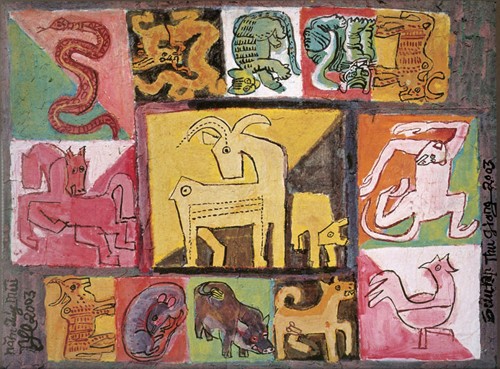(VOVworld) – Painter Nguyen Tu Nghiem was of the first generation painters in Vietnam’s revolutionary fine arts. He was famous for painting lacquer, oil-on-canvas and pigments. Lan Anh reports.
 |
| The calf, 1957 (Photo: english.vietnamnet.vn) |
Nghiem was born on October 20, 1922, in Nam Dan district, Nghe An province. In 1941, he studied at the Indochina Fine Arts College together with painter Bui Xuan Phai, who was famous for paintings of Hanoi’s Old Quarter. In his third year, Nghiem was taught by well-known painter To Ngoc Van who instructed him in fine arts, painting techniques and oil-on-canvas painting. Dr. Nguyen Do Bao, former Chairman of the Vietnam Fine Arts Association, said: “Painter Nguyen Tu Nghiem quickly caught up with contemporary art. While in the Indochina Fine Arts College, Nghiem had a chance to learn Western art and culture. But, he managed to combine his knowledge of Vietnam’s traditional culture with modern art”.
Nghiem was also greatly influenced by painter Nguyen Do Cung, a well-known Vietnamese painter of the 20th century. During the war time, both painters visited many temples and pagodas to study folk culture and painting. Nghiem said he was most influenced by painters To Ngoc Van and Nguyen Do Cung for their knowledge about traditional culture and fine arts. Nghiem’s first oil-on-canvas “Guard of the Temple of Literature” won the first prize at the Salon Unique fine arts exhibition in 1944.
During the war of resistance against French colonialists, Nghiem taught at the Resistance School of Fine Arts in Viet Bac revolutionary base and then at the Hanoi Industrial Fine Arts College from 1959 to 1960. During this time, Nghiem created his own genre applying reality and his imagination. His painting “Lion Dance” with intentionally disfigured faces creates special art effects, and “Ancient dance” features the sculptural works at communal houses spotted by Nghiem and painter Nguyen Do Cung during their field trips. Nghiem’s “Buffalo Calf” lacquere painting, which reflects reality, is now displayed at the Vietnam Fine Arts Museum. Dr. Nguyen Do Bao said: “The painting depicts changes in Vietnam’s rural areas and was painted in Dong Ho folk painting style. There are different people in the painting such as an old woman, children, and young people but all are clearly depicted with different characteristics”.
 |
| The 12 animal designations, 2003. |
During the last days of his life, Nghiem painted 12 zodiac animals with different postures, colors and styles. Nghiem was one of few artists to introduce folklore in Vietnam’s contemporary fine arts. Painter Vi Kien Thanh, Head of the Fine Arts, Photography and Exhibition Department, said: “Nguyen Tu Nghiem’s paintings are unique and creative. Vietnam’s tradition can be seen in Nghiem’s contemporary lacquer paintings”.
Painter Nguyen Tu Nghiem was a pioneer in Vietnam’s contemporary art and one of the last painters of the Indochina Fine Arts College. His paintings were highly appreciated in Vietnam’s contemporary fine arts.